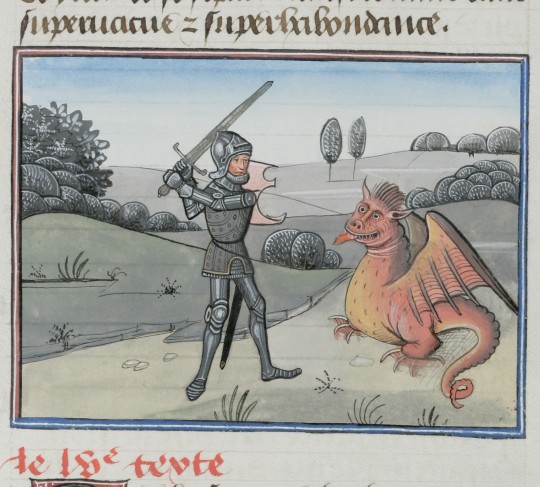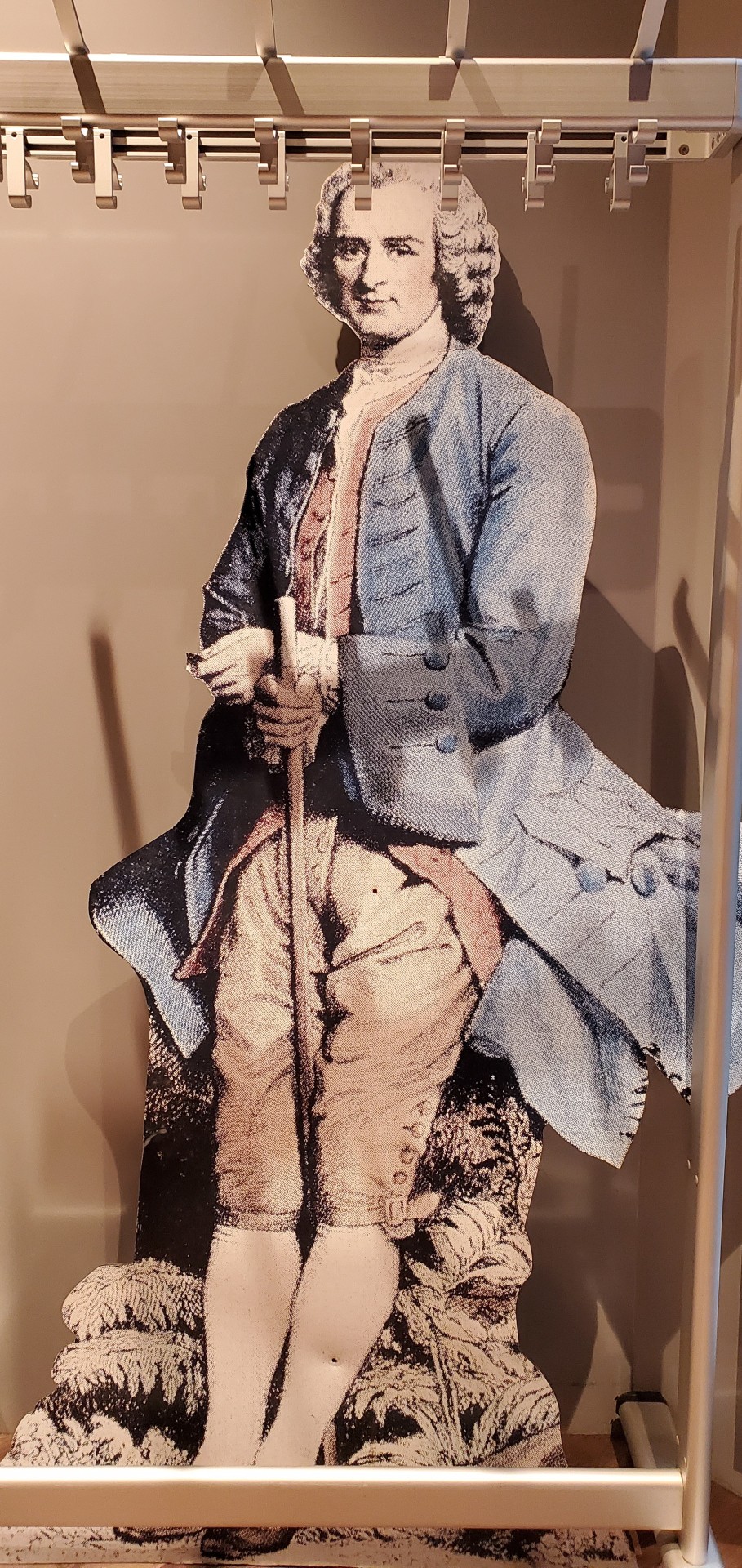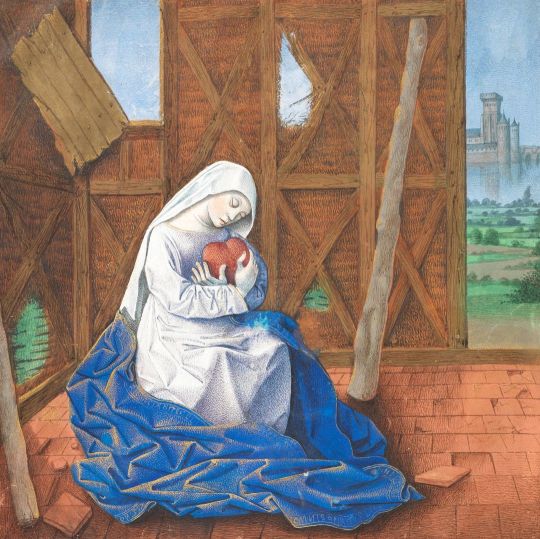#Fondation Martin Bodmer
Text




unusual encounters
illustrations for "l'épître d’othéa" by christine de pizan, france, c. 1460
source: Cologny, Fondation Martin Bodmer, Cod. Bodmer 49, fol. 17r, 55r, 82v, and 84r
#i loove the artstyle of this manuscript it's so unique#15th century#christine de pizan#monsters#dragons#sea monsters#knights#épître d’othéa#medieval art
780 notes
·
View notes
Text
I went to the fondation Martin Bodmer for their exhibition on Dante, and when I came in there were lots of coats and scarves on the clothing rack in the lockers room, but then the many students left, taking back their clothes and revealing...
A JEAN-JACQUES


76 notes
·
View notes
Text

Christine of Pisan, Epitre d'Othea ~ 1460 Fondation Martin Bodmer Cologny
0 notes
Text
Princely Byzantine Gold Necklace with Large Pendants of Pearls, Sapphires and Emeralds


This outstanding necklace is among the finest pieces of early Byzantine jewelry still preserved today. It is constructed of gold, beads, sapphires, emeralds, amethysts and glass paste.
The most important ornament of the necklace is a crossshaped pendant composed of oval sapphires. On each side are three other wheel-shaped and disk-shaped pendants. They are separated by small cylinders. The rest of the necklace includes rhomboid and cylindrical elements decorated with precious stones and connected by small gold links. The clasp consists of two other medallions, to which a hook and a loop are soldered. The entire setting is made of gold, including that of the pendants in the shape of shallow cups. The beads are combined with precious stones such as sapphires, emeralds and amethysts.
The many precious stones and beads, as well as the splendor displayed by the very complex structure of the necklace, are absolutely unique. Only an extremely wealthy person would have been able to acquire such a treasure and only a very high-ranking woman could have worn it. It is almost incredible that such a valuable, fragile necklace escaped vandalism (breaking up to salvage prized materials)! Although the beads have suffered from dryness, they are almost all still in place. Six rhomboid cabochons (gemstones or glass paste) are lost. The four circular settings are also empty; they would have contained other precious stones, enamel or cameos (especially in the two elements placed on the décolleté). The necklace is perfectly structured (precious stones, beads, rock crystal, glass paste and enamel), with a flawless alternation of the materials and colors. The piece is very elaborate and shows highly technical skills. This trend for splendor was often criticized by the clergy, like the Christian author Tertullian, who exhorted the faithful to exercise greater modesty.
Examples of cameo necklaces are documented thanks to the Egyptian necklace belonging to the treasure of Antinopolis, now in the Antikenmuseum in Berlin (inv. 30219508b), and by a large medallion featuring an Annunciation, housed in a private collection (cf. J. Spier). The use of enamels is attested by the rich bindings of liturgical books and by gold altarpieces such as the Pala d’Oro, the retable of Saint Mark’s Basilica, in Venice, utilizing the same mounting technique
Published: CHAMAY J., Objets d’exception (Fondation Martin Bodmer), Genève, 2010, pp. 28-29 et 35 (Bibliographie)
1 note
·
View note
Text
Sundial

The city of clocks
said. I have hidden time for
you to find. My child.
—
—
Fondation Martin Bodmer, Cologny
—
#geneva#genève#switzerland#suisse#fondation martin bodmer#museum#sundial#travel#travel photography#amateur photography#haiku#not a haiku#haiku series#short poem#short poetry#poem#poetry#poetry project#poetry community#creativepromptsforwriting#march prompts#clock
2 notes
·
View notes
Text
Un regard inédit sur Martin Bodmer

Le Bodmer Lab compte deux nouvelles publications qui viennent de paraître aux Éditions d’Ithaque, des ouvrages fondamentaux pour appréhender le projet intellectuel de Martin Bodmer dans toute sa richesse.
De la littérature mondiale, fruit d’une collaboration entre Jérôme David et Cécile Neeser Hever, est une anthologie des principaux textes de Martin Bodmer sur la question de la « Weltliteratur », traduits en français pour la première fois. Un lot de 150 carnets de notes inédits, rédigés par Martin Bodmer entre les années 1920 et 1960, constitue le cœur de cette anthologie. On y suit l’évolution de la philosophie de la littérature mondiale qui a orienté la collection Bodmer.
Martin Bodmer et les promesses de la littérature mondiale est un essai de Jérôme David qui inscrit la trajectoire intellectuelle de Martin Bodmer dans la turbulente histoire du XXe siècle. Bodmer a d’abord envisagé sa collection comme une histoire de l’esprit humain sur quatre millénaires avant qu’il ne vienne à la considérer, dès l’avènement de Hitler au pouvoir, comme l’un des seuls refuges possibles d’un humanisme préservé des mythes nazis. Au cours des années 1950, Martin Bodmer associera toujours plus son immense bibliothèque à une tentation mystique : assembler un Tout de la culture humaine qui laisserait entrevoir une puissance supérieure à l’humanité.
On découvre dans cet essai que l’engagement de Bodmer dans le Comité International de la Croix Rouge à partir de 1939 s’est nourri des mêmes idéaux que son projet intellectuel de collectionneur. La Bibliotheca Bodmeriana est une matérialisation de « l’Esprit de Genève » dans le domaine de la littérature : une utopie concrète au service de la paix mondiale. À la lumière de ces deux ouvrages, Martin Bodmer acquiert la stature d’un penseur d’envergure européenne.

Extrait du carnet de note n° 85 de Martin Bodmer, daté de 1944:
Le seul qui, jusqu’à présent, ait lui-même incarné la littérature mondiale, c’est-à-dire le seul qui n’en ait pas seulement fait partie ou abordé le sujet par écrit, c’est Goethe. À un moment singulier de son existence, des Conversations avec Eckermann à la fin du Faust, il fut la littérature mondiale et il le savait.
Qu’est-ce que la littérature mondiale, sinon la prise de conscience de l’action et de la réaction (si ce n’est celles-ci même) de forces culturelles translocales et transnationales sur l’esprit humain ?
Au début et avant tout autre chose, il y eut la Bible. Ensuite l’Antiquité dans toutes ses ramifications (poésie, art, philosophie, science, politique, droit etc.). Enfin, l’idée même d’humanité. C’est à l’aune de cette dernière que Goethe apparaît comme une somme où la notion de cosmopolitisme (quelle qu’en soit la forme rêvée ou effective, c’est-à-dire sans en fixer la notion) n’est pas sans importance. De son vivant, déjà, des voix nationalistes s’élevaient contre une telle idée ! Ainsi Arndt dans « Ne vous laissez pas tenter, ou la littérature mondiale » (1842). Ou encore Wienbarg (1835). C’est ici déjà qu’émerge cet esprit antagonique qui courra ensuite si glorieusement à sa perte avec le nazisme ! Le danger d’un tel esprit — un danger qui trouve ses racines dans la nature allemande — tient à ce qu’il cherche à concrétiser le romantisme (la sensibilité romantique) dans la réalité ! Il veut imposer l’irrationnel avec des moyens rationnels. Et il échoue dans cette tâche surhumaine.
Hitler est le mélange funeste (plus dangereux encore que l’acide picrique !) de la conception philosophique d’un mythe romantique et de la puissance que donne un empire, du Zarathoustra à l’entreprise Krupp… Mais les instincts qui mènent au titanisme et au crépuscule des dieux sont aussi allemands que les instincts d’organisation, de discipline et de sentimentalité […] et lorsqu’ils se rejoignent, comme dans le nazisme, ils menacent d’annihiler le monde. Ce composé est plus terrible qu’une bombe atomique. On ne peut s’en prévenir par la coercition et la police, mais seulement par le soin systématique de l’autre versant de la nature allemande : l’esprit de Goethe — soit le sens de la mesure, de l’organique, de l’humain — et même par le sens allemand de la littérature mondiale. (« La poésie allemande présente un cabinet d’histoire naturelle presque complet géographiquement, avec toutes les nationalités de chaque époque et de chaque région du monde ; il n’y manque, dit-on, que la nationalité allemande » écrit Friedrich Schlegel dans Sur l’étude de la poésie grecque). À côté de son versant nibelungien — qui, une fois uni à son versant militaire, devient dangereux — l’Allemand possède aussi un « versant grec » (et ceci, non au sens idéaliste de Winckelmann et de Humboldt, mais dans ce sens plus grand, et romantique, que goûtait Nietzsche !) et c’est ce versant qu’il convient de cultiver ! De même que l’Anglo-Saxon est plus proche de l’attachement romain à l’État, et son héritier moderne, l’Allemand serait plus proche des Grecs. Mais lorsqu’il se veut bâtisseur d’empire dans l’esprit des Nibelungen, il échoue et conduit le monde au chaos ! Voilà le sens de cette guerre ! […]
Donc : esprit de Goethe, esprit grec, humanité, littérature mondiale — voilà les qualités allemandes qu’il faut recommencer à développer ! Le peuple allemand a tout intérêt à ne pas se laisser à nouveau sacrifier […] sur l’autel d’un paradoxe romantique — mais le reste du monde aussi ! Certes, une partie des Allemands veut le sacrifice, abhorre le « goethéen », veut teutoniser le monde extérieur qu’il comprend de travers. Il veut la « réalité romantique » — ou la chute délibérée… ! Contre cela, il n’y a rien à faire — mais ne pas les laisser prendre le dessus sur les « Grecs », voilà ce qu’il faut faire !
Martin Bodmer, De la littérature mondiale,
trad. C. Neeser Hever, éd. J. David et C. Neeser Hever,
Paris, Éditions d’Ithaque, 2018, pp. 174-177.
Jérôme David et Cécile Neeser Hever nous présentent leurs ouvrages de vive voix via cette vidéo tournée au sein du Bodmer Lab.
#bodmer#martin bodmer#bodmerlab#bodmer lab#bodmeriana#Fondation Martin Bodmer#Livres#bookworm#books#université de genève#unige#digitization#numérisation#sciences humaines#humanités digitales#digital humanities#littérature#littérature mondiale#weltliteratur#literatur
2 notes
·
View notes
Photo

Lucifer. Doktor Fausts Dreifacher Höllenzwang ~ 18th century. Cologny • via Bibliothèque Infernale on FB
You can enjoy this black magic manuscript, by courtesy of Fondation Martin Bodmer, here:
https://www.e-codices.unifr.ch/en/thumbs/fmb/cb-0066/
“At the beginning of the 17th century, a book of black magic was published, attributed to the mythical Faust and known by the title Höllenzwang. The library in Weimar owned a manuscript of this text, which Goethe was aware of. In 1949 Martin Bodmer was able to purchase a similar manuscript. This document, which is difficult to date, is written in cabalistic signs and, according to a German gloss, contains a series of magic spells for exorcists, which can be used in particular to call up the seven evil spirits. (red)”
125 notes
·
View notes
Photo

Fondation Martin Bodmer, Des jardins & des livres (Geneva, 2018)
1K notes
·
View notes
Photo

Doktor Fausts Dreifacher Höllenzwang, middle of the 18th century, Cologny, Fondation Martin Bodmer, Cod. Bodmer 66.
851 notes
·
View notes
Note
Wait is thus the venetian Prophesies? Where sebile is in love with lamorak? At any rate what edition are you reading I've been looking for that forever 👀👀
It is!!! My edition is based on MS Bodmer 116 and is published by the Fondation Martin Bodmer, edited by Anne Berthelot! Unfortunately I think it is more a transcription than an edition and therefore requires a good-ish grasp of old French. If you're interested in the plot I think there is an old commentary in English by Lucy Patton (from 1920 and based on another MS) and one in modern French by Nathalie Koble, which I recommend if you are able to read French!
You can also look at the MS and at the funny pictures of the clerk flying around on the rock here: https://www.e-codices.unifr.ch/en/list/one/fmb/cb-0116
I'm not working on the enchantresses so could be that I wasn't paying much attention, but Sebile is pretty much in love with everyone she comes across in this text so it wouldn't surprise me if she was in love with Lamorak at some point? She is however definitely in love / lust with a man called Berengier whose baby she and Morgan stole (?? idk what's going on with those two anymore honestly)
#if there are passages you are particularly interested in I can look it up if you want! But the edition is a mess#and difficult to navigate so it might take me time to get round to it#IM SO SORRY THESE TEXTS ARE SO INACCESSIBLE IT DRIVES ME CRAZY#asks
2 notes
·
View notes
Text









noblewomen's headwear
in 15th c. manuscript illustrations, mostly french and dutch
sources: Paris, BnF, Français 2693, fol. 64v // Cologny, Fondation Martin Bodmer, Cod. Bodmer 53, fol. 3r // Paris, BnF, Ms-5070 réserve, fol. 120r, 260v, and 387r // Basel, Universitätsbibl., O I 18, fol. 50v // Vienna, ÖNB, Cod. 1857, fol. 51r // Paris, BnF, Français 77, fol. 242v // Cologny, Fondation Martin Bodmer, Cod. Bodmer 49, fol. 91r
#historically unmatched hat game imho#15th century#medieval fashion#medieval hats#medieval women#headwear#hats#fashion history#illuminated manuscripts#medieval art
266 notes
·
View notes
Text

An image made in 1470 by the French miniature painter Jean Colombe, used to illustrate an allegorical poem, showing bombards and damage to a castle wall.
Credit...Cologny, Fondation Martin Bodmer
6 notes
·
View notes
Photo

René of Anjou, Le mortifiement de vaine plaisance, France ca. 1470 (Cologny, Fondation Martin Bodmer, Cod. Bodmer 144, fol. 3v)
12 notes
·
View notes
Photo

New Post has been published on https://techcrunchapp.com/frankensteins-castle-is-now-have-become-a-tourist-attraction/
Frankenstein’s castle is now have become a tourist attraction

Student of records and manual Cyrille has been taking me across the Swiss metropolis on a Frankenstein go to and the sculpture of the beast at Plainpalais, the web page in which it submitted its first homicide, was too acceptable a photograph occasion to miss.
Frankenstein is a specialty however developing fascination in Geneva, energized by the bicentenary of the beast’s creation. It was in June 1816, 200 years prior, that a gathering of five youngsters from England accumulated in an estate sitting above Lake Geneva and attempted to unnerve each other with apparition stories.
‘Waking dream’
According to the current travel stories blog, one of them, 18-year-old Mary Godwin, had a “waking dream” which she related one night and mesmerized her crowd, which incorporated the English sentimental writer Lord Byron.
Mary was joined by her future spouse, the 23-year-old artist Percy Shelley, who had relinquished his first wife and youngsters to abscond with Mary. They were all free-thinking bohemian spirits – what we would call today elective creative’s.
Byron urged Mary to record her frightening story; she began promptly and called it “Frankenstein or the Modern Prometheus.”
The best travel journal online blog stated A duplicate of that first release gazes me in the face. It’s one of the six creator’s duplicates Mary Shelley got herself and it’s brimming with comments; most would discover their way into the subsequent version.
Artistic summer
The Geneva-based Fondation Martin Bodmer, perhaps the greatest library of uncommon books on the planet is praising the bicentenary of Mary’s bad dream with a show. There are pictures, canvases, first versions, and original copies that clarify the foundation and reproduce the setting of that abstract summer.
Teacher David Spurr from the University of Geneva, the keeper of the show, fills me in.
He shows the 1816 meteorological records from Switzerland; the most extreme temperature in June fluctuated between 10-12 C (50-53 F). A manually written note says that even toward the month’s end “there was not a solitary leaf on the oak trees.”
Today Villa Diodati is exclusive; however, the delightfully manicured gardens are periodically open to general society.
Birches, pines, and lime trees ascend over the blended fragrances of rose nurseries, lavender supports, and columns of citronella hedges. Muscat plants encompass the manor slopes, as they did in Byron’s time; and somewhere out there the Jura Mountains rise delicately over Lake Geneva. The nurseries are a spot for motivation now as they were at that point.
In the estate, the youthful companions read a collection of German phantom stories by candlelight. At the point when that was finished, Byron urged them to develop shocking tales of their own.
This is the place where Mary Shelley came up trumps with her considerations of what might occur if a researcher-made life utilizing power. Tests with this new actual wonder were extremely popular at that point and individuals were especially captivated with its capacity to cause spasms.
Destroyed château
The top travel blog in usa stated In 1803 Giovanni Aldini, an Italian researcher broadly passed an electric momentum through the body of a balanced man before a welcomed crowd in London; the group thundered as his dead jaws started jerking and his inert appendages began moving.
Mary’s book was distributed to extraordinary well-known achievement, yet the primary version didn’t bear her name; the distributer accepted that deals would endure if peruses realized that it was crafted by a young lady.
Precision robots
The Shelleys cruised on the Rhine in transit back to London. It’s conceivable, yet obscure whether Mary had the opportunity to visit those two locales.
Teacher Spurr offers another alternative; he gives me a French volume by Francois Felix Nogaret, called “The Mirror of True Events” distributed in 1790.
Whatever the motivation, it’s Mary Shelley’s creation that turned into the object of our interest; she can legitimately call “Frankenstein” her own.
2 notes
·
View notes
Photo

Script sampling of Cologny, Fondation Martin Bodmer, Cod. Bodmer 48 f.93r
7 notes
·
View notes
Text
Article de la Tribune de Genève
Vou retrouverez ici un article publié sur la TDG!
#bodmer#book#bookworm#rare books#martin bodmer#Fondation Martin Bodmer#bodmerlab#bodmer lab#digitization#digitisation#digital humanities#humanités digitales#université de genève#universitédegenève#unige#bibliophile#bibliothèque
1 note
·
View note